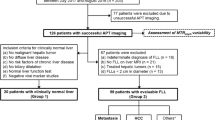Abstract
The role of excitation-spoiling fat suppression (fatsat) imaging in the detection of liver lesions was assessed comparing short TR/TE and long TR/ TE spin-echo (SE) sequences with and without excitation-spoiling fat suppression in 25 patients at 1.5T. The study included patients with liver metastases (n = 21), primary liver cancer (n=3), and hepatic adenoma (n=1). Liver lesion detection and lesionliver signal-to-noise ratios (SNR) were determined for the various imaging sequences in a prospective fashion. Liver lesion-liver SNR were highest for long TR/TE (2000-2500/70-80) fatsat images (12.7±4.8) compared to long TR/TE regular SE (2000-2500/70-80) images (8.8±5.6) [(p = ns) (not significant)], short TR/TE (200-400/15-20) fatsat images (-6.2±4.8) (p=0.05), and short TR/TE regular SE images (-4.9±3.2) (p<0.01). Lesion detection was greatest for long TR/TE fatsat (86) followed by long TR/TE regular SE (78) (p=0.05), short TR/TE fatsat (65) (p<0.01), and short TR/TE regular SE (60) (p<0.01). The results of this study suggest that excitation-spoiling fat suppression may improve liver lesion detection and conspicuity.
Similar content being viewed by others
References
Heiken JP, Weyman PJ, Lee JKT, et al. Detection of focal hepatic masses: prospective evaluation with CT, delayed CT, CT during arterial photography, and MR imaging. Radiology 1989;171:47–51
Stark DD, Wittenberg J, Butch RJ, Ferrucci JT. Hepatic metastases: randomized, controlled comparison of detection with MR imaging and CT. Radiology 1987;165:399–406
Reinig JW, Dwyer AJ, Miller DL, et al. Liver metastases detection: comparative sensitivities of MR imaging and CT scanning. Radiology 1987;162:43–47
Paling MR, Abbitt PL, Mugler JP, Brookeman JR. Liver metastases: optimization of MR imaging pulse sequences at 1.0 T. Radiology 1988;167:695–699
Dousset M, Weissleder R, Hendrick RE, et al. Short T1 inversion recovery imaging of the liver: pulse-sequence optimization and comparison with spin-echo imaging. Radiology 1989;171:327–333
Rummeny E, Saini S, Stark DD, Weissleder R, Compton CC, Ferrucci JT. Detection of hepatic metastases with MR imaging: spin-echo vs phase-contrast pulse sequences at 0.6 T AJR 1989;153:1207–1211
Winkler ML, Thoeni RF, Luh N, Kaufman L, Margulis AR. Hepatic neoplasia breath-hold MR imaging. Radiology 1989;170:801–806
Mirowitz SA, Lee JKT, Brown JJ, Eilenberg SS, Heiken JP, Perman WH. Rapid acquisition spin-echo (RASE) MR imaging: a new technique for reduction of artifacts and acquisition time. Radiology 1990;175:131–135
Shuman WP, Baron RL, Peters MJ, Tanzioli PK. Comparison of STIR and spin-echo MR imaging at 1.5 T in 90 lesions of the chest, liver, and pelvis. AJR 1989;152:853–859
Daniels DL, Kneeland JB, Shimakawa AJ, et al. MR imaging of the optic nerve and sheath: correcting the chemical shift misregistration effect. Am J Neuroradiol 1986;7:249–253
Semelka RD, Chew W, Hricak H, Tomei E, Higgins CB. Fat saturation MR imaging of the upper abdomen. AJR 1990;155:1111–1116
Semelka RC, Hricak H, Stevens S, Tomei E, Carroll PR. Combined gadolinium-enhanced and fat-saturation MR imaging of renal masses. Radiology 1991;178:803–809
Mitchell DG, Vinitski S, Saponaro S, Tasciyan T, Burk DL JR, Rifkin MD, Liver and pancreas: improved spin-echo T1 contrast by shorter echo time and fat suppression at 1.5T. Radiology 1991;178:67–71
Stark DD, Wittenberg J, Edelman RR, et al. Detection of hepatic metastasis by magnetic resonance: analysis of pulse sequence performance. Radiology 1986;159:365–370
Foley WD, Kneeland JB, Cates JD, et al. Contrast optimization for the detection of focal hepatic lesions by MR imaging at 1.5T AJR 1987;149:1155–1160
Reinig JW, Dwyer AJ, Miller DL, Frank JA, Adams GW, Chang AE. Liver metastases: detection with MR imaging at 0.5 and 1.5T Radiology 1989;170:149–153
Vinitski S, Mitchell DG, Szumowski J, Burk KL Jr, Rifkin M. Variable flip angle imaging and fat suppression in combined gradient and spin-echo (GREASE) techniques. Magn Reson Imag 1990;8:131–139
Mitchell DG, Vinitski S, Rifkin MD, Berk DL Jr. Sampling bandwidth and fat suppression: effects on long TR/TE MR imaging of the abdomen and pelvis at 1.5T AJR 1989;153: 419–425
Warwick R, Williams PL. Splanchnology. In: Warwick R, Williams PL, eds. Gray's anatomy. Edinburgh: Longman, 1973:1303–1304
Author information
Authors and Affiliations
Rights and permissions
About this article
Cite this article
Semelka, R.C., Hricak, H., Bis, K.G. et al. Liver lesion detection: Comparison between excitation-spoiling fat suppression and regular spin-echo at 1.5T. Abdom Imaging 18, 56–60 (1993). https://doi.org/10.1007/BF00201703
Received:
Accepted:
Issue Date:
DOI: https://doi.org/10.1007/BF00201703




